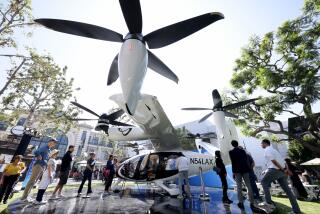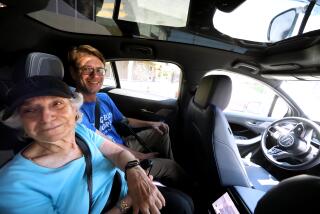Hardly Fare Out There : Cabbies, Like Everyone Else, Are Reeling From the Recession
Taxi driver Bill Jimenez was about to steer his cab to the front of a mid-Wilshire hotel when a rival cabbie cut in and hijacked the waiting passengers.
âHey man, you werenât even the first,â Jimenez yelled at the offending driver, who sped off into morning traffic. âHe did wrong. If we donât respect each other, we will be out there beating each other up for the money.â
Respect and passengers are in short supply these days as the more than 2,400 legal and illegal Los Angeles taxi drivers struggle to maneuver through a lengthy recession and an economy undergoing dramatic, long-term changes. As a result, many drivers are working harder and longer for less money than they did a few years ago.
For cabbies who prospered in the 1980s, Southern Californiaâs economic downturn is especially painful--and it may be long lasting. As residents and visitors look for ways to save money, a taxi ride is easy to pass up.
The switchboard at Taxi Systems--which operates LA Taxi, where Jimenez works--receives âa couple of thousandâ fewer calls a day that it did two years ago, said Dennis Rouse, senior vice president of the Gardena-based firm. Drivers are making $20 to $30 less a day, and the company has reduced its active fleet by nearly 15%, to about 280 cars.
âIf I had a full complement of cars on the streets, the men would not be able to make a living,â Rouse said.
Despite the harsh economic reality for cab drivers, there is no shortage of applicants for driving jobs, said Rouse. Many, however, do not last more than a day in what amounts to a daily street battle for customers even in the best of times.
âCab driving is hustling,â said Jimenez, a 38-year-old Los Angeles native with wiry black hair and a neatly trimmed mustache. âWhile you are sitting, you are not making a dime.â
A good example is Los Angeles International Airport, where drivers wait up to two hours in a holding pen for a passenger who might travel to downtown Los Angeles--a $24 fare--or El Segundo--$5. Competition is also keen on Bunker Hill, where attorneys often send their secretaries home on a $40, $50 or $60 ride after a long work day, Jimenez said.
During the boom years of the 1980s, rich Japanese tourists would plop themselves in the back of Jimenezâs cab and simply say: âShow me L.A.â Once, a Mexican businessman paid him $600 for a day of driving.
Those are only sweet memories now for Jimenez, whose daily earnings have fallen from a minimum of $200 to about $140 for a 12-hour shift.
From those earnings, Jimenez must subtract at least $60 a day to pay for gas, food and the Chevrolet Caprice that he and his brother lease from LA Taxi.
As the economy has soured, Jimenez has seen fewer flag-downs (passengers who hail cabbies) and more run-outs (passengers who skip payment). From the back seat, passengers bargain for lower fares and offer theories as to why times are so bad. âThe banks are holding up the money until the election is overâ is a popular one.
Jimenez and other licensed drivers must also compete with growing numbers of unlicensed bandit cabs, which seem to outnumber legal cabbies on some street corners. The recession may have forced many bandit drivers into the trade, but Jimenez has little sympathy.
âI paid my dues. I paid my taxes. I paid the company. I paid the city license,â said Jimenez. âI figure they need to pay their dues too.â
To boost his earnings, Jimenez has turned to working nights. But during one evening stint, the 17-year taxi veteran went home with $11 in his pocket. âAnd Iâm a professional,â he said, humbled by the poor performance.
Driving nights may also have contributed to the breakup of his second marriage, Jimenez said.
âItâs hard on us. Itâs hard on our families. We are behind the wheel all the time trying to make it.â
Jimenez spends most of the time driving the crowded streets and densely populated neighborhoods of Koreatown, Westlake and Pico Union, where he lives. Parked out front of the Sheraton Townhouse hotel, he can quickly respond to calls from senior citizens with doctors appointments and Central American homemakers on the way home with grocery bags. The trips are short, but frequent.
âWhen the vacationers are gone, these people are still here kicking in good money daily,â Jimenez said. âYou have to depend on the people here.â
On a hot and muggy morning, after nearly an hour wait outside the Sheraton, a message flashed across the dash-mounted computer screen in Jimenezâ cab: Thereâs a call for a cab a few blocks away. Jimenez hit a button on the terminal to respond and drove off to an apartment house off Rampart Boulevard, where an elderly woman wanted a ride to St. Vincent Medical Center.
The ride to St. Vincent added up to only $2.70 on the meter and a $1 tip. But no fare is too small these days, and itâs better than just sitting around.
âI just like to keep moving,â said Jimenez, parked outside the Sheraton, waiting for the next fare.
More to Read
Sign up for Essential California
The most important California stories and recommendations in your inbox every morning.
You may occasionally receive promotional content from the Los Angeles Times.










